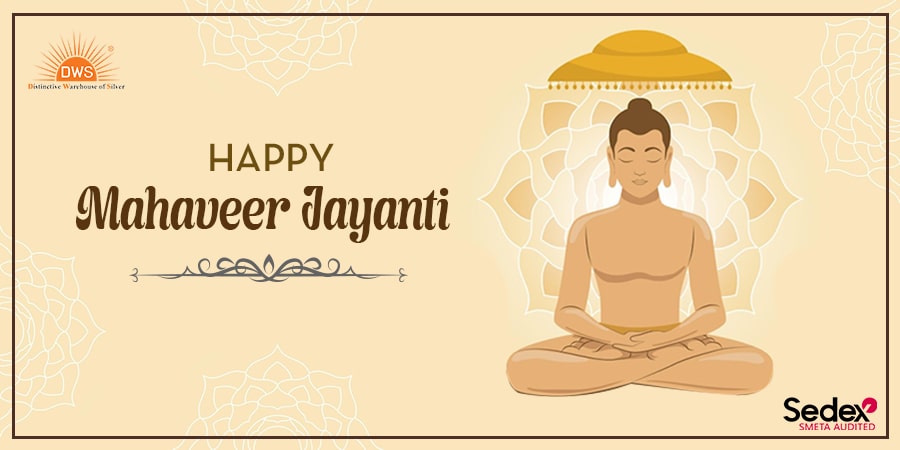- Written By Team DWS
- Festivals
- April 08, 2025
The Significance of Mahavir Jayanti: Understanding the Teachings of Lord Mahavir
Mahavir Jayanti, observed by millions globally, commemorates the birth of Lord Mahavir, the 24th Tirthankara (spiritual guide) in Jainism. This auspicious day usually falls on the 13th day of the rising moon in the month of Chaitra, making it an event of profound significance for Jain communities globally. As those observing this day participate in various rituals, prayers, and community service, it’s essential to delve into the teachings of Lord Mahavir, which continue to inspire individuals towards the path of righteousness and spiritual awakening.

The Life of Lord Mahavir
Born as Vardhamana in 599 BCE in Vaishali, India, Mahavir was raised in a royal family and led a life of luxury. However, at the age of 30, he renounced his princely life in search of deeper spiritual understanding. For the next twelve years, he engaged in rigorous meditation and ascetic practices to attain enlightenment. Upon achieving keval jnana (absolute knowledge), Mahavir spent the subsequent 30 years preaching his insights and philosophy of non-violence, truth, and self-discipline.
Central Teachings of Lord Mahavir
- Ahimsa (Non-Violence): Perhaps the most profound of Mahavir's teachings is ahimsa, advocating for the complete avoidance of harm to any living being. This principle is foundational not just in Jainism, but also resonates across various philosophies, promoting compassion and empathy in our daily dealings.
- Satya (Truthfulness): Mahavir emphasized the importance of truthfulness in all aspects of life. He believed that truth should be the guiding principle of one’s thoughts, words, and actions. Speaking truth fosters trust and integrity, essential values for harmonious societal living.
- Aparigraha (Non-Possessiveness): Lord Mahavir taught that attachment to material possessions leads to desires and suffering. By practicing non-possessiveness, individuals can attain liberation from the cycle of birth and rebirth (samsara) and can achieve a state of peace and contentment.
- Brahmacharya (Celibacy): Mahavir's teachings also include the practice of celibacy as a means to control desires and achieve spiritual purity. In a modern context, this principle subliminally encourages individuals to engage in self-control and discipline in all aspects of life.
- Karma: Understanding karma is pivotal in Mahavir's philosophy. According to him, every action (good or bad) has consequences that impact not only this life but future existences as well. This acts as a guiding principle for ethical behavior and personal development.
The Role of Mahavir Jayanti in Jain Culture
On Mahavir Jayanti, devotees engage in activities reflecting the core teachings of Lord Mahavir. Religious processions, visits to temples, and community service mark the day. Many people observe fasting and engage in acts of charity to honor the life of Mahavir and live out his teachings.
The celebrations often begin with a ceremonial bathing of the idol of Lord Mahavir, symbolizing purity and reverence. Followers chant hymns and conduct prayers, reinforcing their spiritual commitment to the principles Mahavir espoused. Temples are often adorned with flowers and decorations, and communities gather to share insights and stories about their beloved Tirthankara.
Promoting Peace and Coexistence
In a world increasingly fraught with conflict, the teachings of Lord Mahavir resonate more than ever. His emphasis on ahimsa encourages a global movement towards peace and non-violent resolutions in conflicts. The Jain community's commitment to non-violence provides a model that can inspire individuals and societies to tackle adversity through understanding and compassion.
Recognizing the interconnectedness of all beings, Lord Mahavir's teachings urge humanity to foster respect for nature and promote environmental sustainability. Understanding the impact of our actions on the planet reflects his philosophical foundations and reinforces our responsibility to future generations.
Conclusion: Living the Legacy of Lord Mahavir
Mahavir Jayanti serves as an important reminder of the relevance of Lord Mahavir's teachings in today's complex world. The principles of non-violence, truthfulness, and self-discipline are not mere religious tenets; they are profound guidelines that can enrich human lives universally.
As we celebrate Mahavir Jayanti, let us not only pay homage to the legacy of Lord Mahavir but also strive to incorporate his teachings into our lives. Whether through acts of kindness, personal reflection, or advocating for justice, we can honor his memory by embodying his values and inspiring others to do the same. Thus, in our effort to embrace these teachings, we contribute to a world radiating peace, compassion, and understanding.
Let the spirit of Mahavir inspire us all to be better individuals and to foster a society that values empathy and harmony. By embodying the ideals of Lord Mahavir, we can challenge intolerance, promote unity, and cultivate an environment where respect for all living beings prevails. In moments of conflict and strife, let us recall his wisdom and choose paths that reflect grace and integrity.
As we reflect on his teachings, may we find the strength to overcome our own shortcomings and rise above divisive narratives. Let Mahavir Jayanti serve as a catalyst for change, urging each of us to actively participate in building a more just and compassionate world, one small action at a time. Together, let’s honor the legacy of Lord Mahavir by being advocates for peace, stewards of truth, and champions of non-violence—extending beyond our individual lives to touch the hearts and minds of those around us.

Mahavir Jayanti FAQs: Common Questions and Answers about the Celebration
Here’s a set of frequently asked questions (FAQs) about Mahavir Jayanti:
1. What is Mahavir Jayanti?
Mahavir Jayanti is the celebration of the birth of Lord Mahavir, the 24th Tirthankara (spiritual teacher) of Jainism. It is one of the most significant festivals for Jains worldwide.
2. When is Mahavir Jayanti celebrated?
Mahavir Jayanti is celebrated on the 13th day of the month of Chaitra in the Hindu calendar, which usually falls in March or April on the Gregorian calendar.
3. Who was Lord Mahavir?
Lord Mahavir, also known as Vardhamana Mahavir, was born in 599 BCE in Kundagrama (now in Bihar, India). He is known for propagating the principles of Jainism, emphasizing non-violence (ahimsa), truth (satya), and asceticism.
4. How do people celebrate Mahavir Jayanti?
Celebrations include prayers, meditation, rituals, and special worship activities in Jain temples. Many devotees also participate in processions, and community service activities, and engage in discussions about Lord Mahavir's teachings.
5. What are some key rituals associated with Mahavir Jayanti?
Key rituals include performing puja (worship) of Lord Mahavir’s idols, reciting Jain scriptures, and organizing community meals (langar). Many followers also engage in acts of charity and spend time in reflection on Jain values.
6. Is Mahavir Jayanti a public holiday?
Mahavir Jayanti is a public holiday in some states of India, particularly in areas with significant Jain populations. It may not be observed as a public holiday everywhere.
7. What is the significance of Mahavir Jayanti?
The festival signifies the teachings and ideals of Lord Mahavir, focusing on non-violence, compassion, self-discipline, and truthfulness. It is a time for Jains to reflect on their spiritual journey and recommit to these principles.
8. Can non-Jains participate in Mahavir Jayanti celebrations?
Yes, non-Jains are often welcome to participate in celebrations, especially in community events. It is a good opportunity for people of all backgrounds to learn about Jainism and its values.
9. What food is associated with Mahavir Jayanti?
During Mahavir Jayanti, many Jains prefer to eat vegetarian food, often abstaining from root vegetables to adhere to the principles of ahimsa. Community feasts or 'langars' may feature a variety of vegetarian dishes.
10. What teachings of Lord Mahavir are emphasized during this festival?
The festival highlights teachings such as ahimsa (non-violence), anekantavada (many-sidedness), and aparigraha (non-possessiveness). Many celebrations include discussions or lectures focusing on these principles.
These FAQs aim to provide an overview of Mahavir Jayanti and its significance, helping both Jains and those unfamiliar with the festival to understand and appreciate its importance.
Popular on Blogs

Black Tourmaline: Meaning, Healing Properties, Fascinating Facts, Powerful Attributes, Versatile Uses, and Beyond
September 05, 2023 / BY Team DWS
Black Tourmaline, also known as Schorl, is a highly revered crystal with incredible metaphysical properties. It derives its name from the Dutch word "turamali," meaning "stone with ..

Carnelian Stone: Meaning, Healing Properties, Power, Facts, Color, Uses and More
December 26, 2023 / BY Team DWS
Carnelian is a vibrant and captivating gemstone that holds a plethora of meanings, healing properties, and powers. Its warm and fiery energy makes it a popular choice among crystal ..

Citrine: Exploring its Meaning, Healing Properties, Fascinating Facts, Powers, Versatile Uses, and Much More
November 18, 2023 / BY Team DWS
Citrine, with its warm golden hues, has captured the attention and imagination of people for centuries. This beautiful gemstone, commonly associated with wealth and prosperity, hol ..

Black Onyx: Unveiling the Meaning, Healing Properties, Fascinating Facts, Powerful Attributes, Versatile Uses, and Beyond
July 25, 2023 / BY Team DWS
Black Onyx, a striking gemstone admired for its deep black hue and elegant appearance, has captivated people for centuries. In this comprehensive guide, we will delve into the mean ..

Unveiling the Mysteries of Turquoise Stone: Exploring its Meaning, Healing Properties, Power, Facts, Color, Uses, and More
December 05, 2023 / BY Team DWS
Turquoise, with its captivating blue-green hue, has been adorning jewelry and artifacts for centuries. This striking stone has a rich history, rich symbolism, and a plethora of int ..

The History Behind The Popularity of Red Agate
December 23, 2022 / BY Team DWS
An Agate is a type of magma rock that takes many years till it is washed out naturally into the water. And that is the reason this stone has elements of water. This beautiful stone ..

Plan a Perfect Valentine's Week with Our Valentine Week List 2025
January 22, 2024 / BY Team DWS
Valentine's Day is undoubtedly the most romantic day of the year, but we believe that one day is just not enough to express your love and make your partner feel special. That's why ..

Bloodstone: Unveiling the Meaning, Healing Properties, Facts, Powers, Uses, and More
August 21, 2023 / BY Team DWS
Bloodstone, with its captivating deep green color with specks of red, is a mesmerizing gemstone that has fascinated civilizations for centuries. It possesses unique healing propert ..


